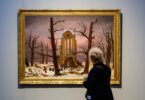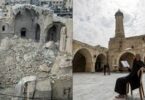Maan Jalal
A historic meeting is set to take place between the leaders of the Nisga’a Nation from British Columbia, Canada, and the National Museum of Scotland.
Scheduled to take place on Monday, it will be the first meeting between the two sides to discuss the return of the wooden Ni’isjoohl memorial pole that was stolen 93 years ago.
“This will be the first time in living memory that members of the House of Nis’sjoohl will be able to see the memorial pole with our own eyes,” said chief Earl Stephens. “This visit will be deeply emotional for us all.”
The totem pole was taken by Canadian anthropologist Marius Barbeau in 1929. He sold it to the National Museum of Scotland 23 years later.
Hand-carved and erected in the 1860s, the cultural treasure tells the story of Ts’wawit, a Nisga’a warrior who was set to become chief when he was killed in battle with a neighbouring nation.
“The pole is a priceless belonging that our respected hereditary leaders have aptly called a cultural treasure,” said Amy Parent, Canada research chair in indigenous education and governance at Simon Fraser University in Vancouver.
“It tells the relationship of our house to the land and to our people. To have had it taken from us is to have removed a piece of our cultural identity and an integral part of the story of our nationhood.”
:quality(70)/cloudfront-eu-central-1.images.arcpublishing.com/thenational/OC7EXFOV2NBCPHKT3RJVEWIS3A.JPG)
Like many other totem poles carved in the Nisga’a tradition, this one is said to hold knowledge within its carvings while also serving as a touchstone for the next generation to learn about their history and way of life through oral traditions.
The memorial pole was stolen at a time when it was common for settlers and anthropologists to take away the belongings of Canada’s indigenous peoples to build their collections. Barbeau, a controversial figure who has been heavily criticised for inaccurately representing indigenous people, took the pole without the consent of the House of Ni’isjoohl, one of the 50 houses within the Nisga’a Nation.
“The United Kingdom voted to support the United Nations Declaration on the Rights of Indigenous Peoples. And this would be a historic and vital act toward the implementation of that resolution,” said Parent.
The 2007 UN declaration says that “states shall seek to enable the access and/or repatriation of ceremonial objects and human remains in their possession through fair, transparent and effective mechanisms developed in conjunction with Indigenous Peoples concerned.”
The delegation will be made up of three members of the House of Ni’isjoohl — Stephens, Parent, and Shawna McKay, along with other witnesses from the Nation.
There is no assurance that the meeting will end with the memorial pole’s return to the House of Ni’isjoohl.
There has only been one instance where a First Nation’s totem pole was returned by a European institution. After 15 years of negotiations, the Swedish Museum of Ethnography formally returned the Haisla G’psgolox pole to the Haisla tribe in Canada.
Courtesy: thenationalnews






